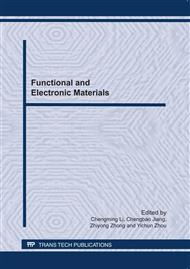p.348
p.354
p.359
p.366
p.370
p.375
p.380
p.385
p.391
Preparation and Relaxor Behavior of Barium Strontium Titanate Glass-Ceramics Doped Si-B-O Sintered from Sol-Gel Derived Powders
Abstract:
The structural and dielectric properties of Si-B-O doped Ba0.60Sr0.40TiO3 (BST) glass-ceramics prepared by using sol-gel derived powders have been investigated. The secondary phase of BaTi2Si2O8 is clearly observable in BST glass-ceramics when the concentration of Si-B-O is equal to or more than 20mol%. The samples with high Si-B-O doping levels can be sintered into dense microstructure in low sintering temperature (below 1000°C). The dielectric peaks of BST glass-ceramics are markedly suppressed, broadened and shifted to low temperature with increasing the concentration of Si-B-O, accompanying an increased diffuseness of the dielectric peak due to the ionic substitution, which follows well the Lorenz-type relation.
Info:
Periodical:
Pages:
370-374
Citation:
Online since:
June 2011
Authors:
Price:
Сopyright:
© 2011 Trans Tech Publications Ltd. All Rights Reserved
Share:
Citation:


